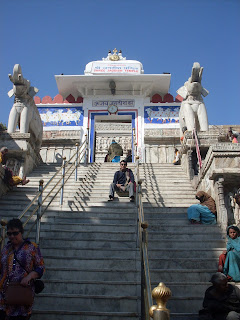 |
| Ashta Vinayak Glory |
We recently undertook a pilgrimage to Ashta Vinayak. It was a 2-day, one night journey. Braving the wintry chill, we set off at 7 a.m. by bus. The first stop was at Morgaon, for darshan of the Lord Mayureshwar, as Lord Ganpati is known here. The idol has the Naga Raja’s hood on its head. It is believed that Lord Brahma had constructed this temple. Legend says that Lord Ganesh, as Mayureshwar (Moresh) or the peacock-rider, vanquished the asura Sindhu, after entreaties by all the Gods. The temple’s Mughal architecture is distinct. A Nandi sitting in front of the temple’s entrance is unique, as this is found only in front of Lord Shiva’s temples.
We had a plate of hot vegetable pohe and tea for breakfast and then set off for Siddhivinayak darshan at Siddhatek, near Daund. God Vishnu supposedly vanquished the asuras Madhu and Kaitabh after propitiating Ganesha here. This Ganapati has his trunk pointing towards the right, hence is known as Siddhivinayak. Devotees can complete the 5 kms. Pradakshina, only by circumambulating the hill.
When we had earlier visited this temple, we had crossed the swollen Bhima river in a row-boat. But now a bridge over the river has made it possible for the bus to directly reach near the temple and cut down the journey time.
Our co-passengers broke juicy, sour tamarinds from the trees and distributed them. After a delicious buffet lunch at a restaurant there, we proceeded further to Theur.
The Chintamani Ganapati of Theur is believed to relieve all the devotees from their worries. The wooden temple has a small stone fountain inside it. A huge paved courtyard, an enormous bell and a Shiva temple, are the other attractions here. It is believed that the Lord retrieved the precious Chintamani jewel from Guna, for Sage Kapila, here. In return, the Sage garlanded him with the jewel and named him as Chintamani Vinayak.
The last Ganapati darshan for that day was of the huge Ranjangaon Ganapati known as Maha Ganapati. This Ganapati had aided Lord Shiva in fighting the demon Tripurasura. This idol is believed to have 10 hands and 20 trunks. The sun’s rays fall directly on the idol, at a particular time of the day.
 |
| The awesome entrance arch of the Ranjangaon Temple |
Security being strict, none of the pilgrims was allowed to carry anything inside the temple. Hence we visited the temple by turns.
Then we went to Lenyadri, watching the movie “Oh My God” enroute; again had a sumptuous buffet dinner and spent the night at the Lenyadri Ganapati Devasthan Trust’s lodgings. The room was very neat, with clean bed-sheets, pillows and blankets. The attached toilet - cum- bathroom was also spic and span.
Next morning at 5.30 a.m., we had tea and started climbing the steep 283 steps to the Lenyadri, the 3rd century, Buddhist-cave shrine of Girijatmaja Ganapati. The idol is carved on the stone wall of the cave and faces eastward, with its trunk turned to the left, with Lord Shiva and Hanuman on either side. Legend has it that Goddess Parvati created her son Ganapati by bringing a mud idol to life there. Lord Ganapati had supposedly spent his childhood days there.
 |
| The steep climb to the cave-shrine at Lenyadri |
A huge horde of monkeys was making its presence felt there. One huge monkey leapt at me and vigorously tugged my carry-bag, denting it. As my husband shooed it off, it retreated reluctantly. A baby monkey clambered on to a man’s back and sat cutely on his head. That man didn’t seem to mind it! We warily descended the hill.
We had a breakfast of piping hot upma and tea at the same restaurant where we had had dinner, shopped for collectibles and resumed our pilgrimage to Ozhar.
The Vighnaharta/Vigneshwara Ganapati of Ozhar relieves one of all the obstacles in one’s life. Lord Ganesha killed a demon named Vighnasur, hence the name. The idol has gems for its eyes, on its forehead and in its navel. Brass statues of His divine consorts Riddhi and Siddhi flank the idol. The temple, with its gold dome, twin deepastambhs (stone pillars for holding oil lamps) and two life-sized, stone-carved, dwarapalas (guards); is awesome.
Behind the temple, was a huge lake. It appeared misty and tranquil. As there wasn’t any time for boating, we started for Mahad.
Mahad, is very far, about 200 kms. from Ozhar. It was a 4- hour journey to this place in Raigad district. En route, we saw fresh sugarcane crop being harvested and ferried for crushing by trucks, tractors and bullock-carts. The cleaner of our bus adeptly pulled some sugar-cane from the passing vehicles and gave them to some passengers (who had strong teeth!).
 |
| The magnificent entrance to the Ozar temple |
 |
| The serene lake behind the Ozar temple |
Then it was time for the last of the Ashta Vinayaks, the Ballaleshwar temple at Pali. This is the only Ashta Vinayak Ganapati named after an ardent devotee of the Lord. The idol in this temple is attired in traditional clothes, as he appeared to Ballal, in the form of a Brahmin. The prasad offered here is besan laddu, instead of the customary modak. The Dhundivinayak Ganapati must be visited before the Ballaleshwar Ganapati, as per tradition.
A refreshing glass of kokam sarbat was served to us instead of tea.Then we returned to Pune at 7.30 p.m.
We had already vowed to return for the pilgrimage at the earliest; as the pilgrimage had satiated our souls.
This travelogue has been published in the Sakal Times' Spice edition dated 28th June, 2015.











